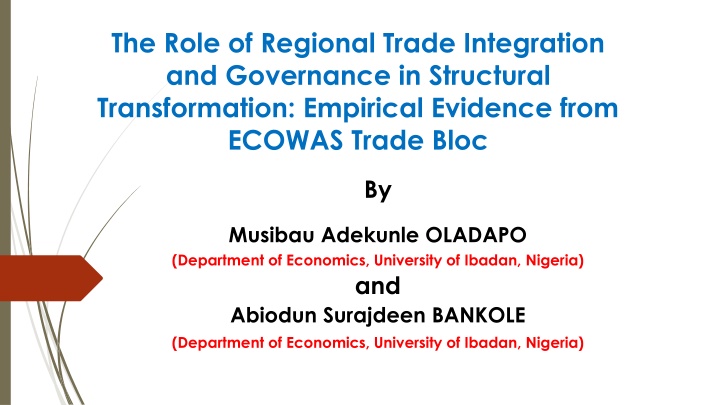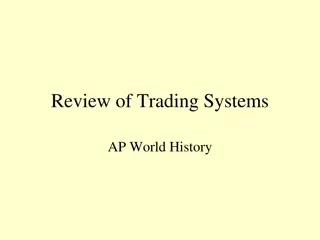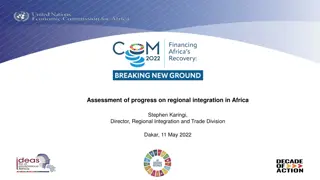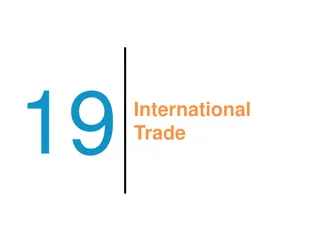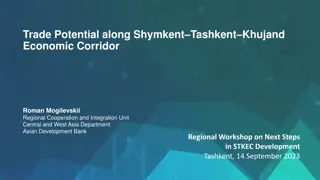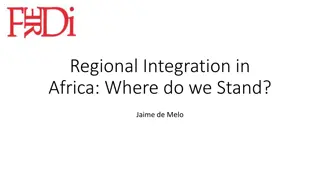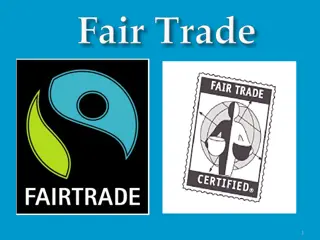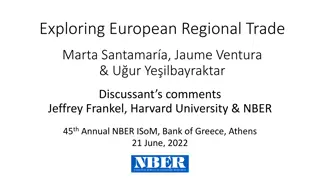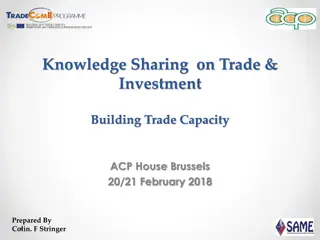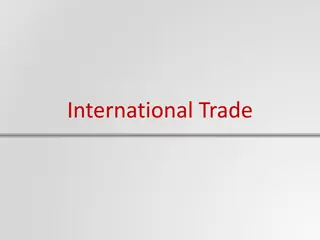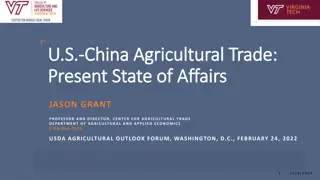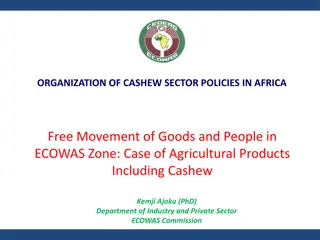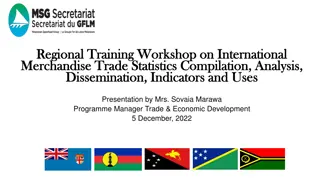The Role of Regional Trade Integration in ECOWAS Bloc
This study explores the impact of regional trade integration and governance on structural transformation within the ECOWAS trade bloc in Africa. It delves into the importance of economies of scale, economic transformation, good governance, and the relationship between trade openness and industrialization. Key findings and recommendations are presented based on empirical evidence.
Download Presentation

Please find below an Image/Link to download the presentation.
The content on the website is provided AS IS for your information and personal use only. It may not be sold, licensed, or shared on other websites without obtaining consent from the author.If you encounter any issues during the download, it is possible that the publisher has removed the file from their server.
You are allowed to download the files provided on this website for personal or commercial use, subject to the condition that they are used lawfully. All files are the property of their respective owners.
The content on the website is provided AS IS for your information and personal use only. It may not be sold, licensed, or shared on other websites without obtaining consent from the author.
E N D
Presentation Transcript
The Role of Regional Trade Integration and Governance in Structural Transformation: Empirical Evidence from ECOWAS Trade Bloc By Musibau Adekunle OLADAPO (Department of Economics, University of Ibadan, Nigeria) and Abiodun Surajdeen BANKOLE (Department of Economics, University of Ibadan, Nigeria)
Outline 2 Introduction Background to the study Literature review Methodology Empirical results Conclusion and recommendation
Introduction Most of the regional economic bodies in developing countries are committed to regional integration for different reasons Agbonkhese and Adekola (2014) assert that in Africa, regional integration is important in order to: take advantage of economies of scale in production and consumption This is because Africa contains small and fragmented economies with low incomes (Karamuriro, 2015) Regional economic integrations can be defined as: formations meant to promote the common economic objectives of countries with similar performances (Atik, 2014) 3
Introduction (Cont.) 4 Economic transformation can be defined as: a structural movement of an economy over time from a lower, rudimentary and subsistence level to a higher and more sophisticated level of economic activities (Ibrahim, 2012). a fundamental change in the structure of an economy and its drivers of growth and development (UNECA, 2013). UNECA (2013) points out that without structural transformation, Africa will not achieve: wealth creation, poverty reduction, improved social environments for its people, sustainable development, and among others.
Introduction (Cont.) 5 Good governance and structural transformation Regional integration without good governance may not ensure economic transformation. When good governance prevails in a country, the expectation is that it will have a positive effect on the structural transformation its economy. Therefore, good governance is important in transforming an economy Conflicting views on trade openness with the rest of the world: Dodzin and Vamvakidis (1999) argue that the more open an economy, the more industrialised. However, King (2007) counters that trade restriction is important in order to protect infant industries. These conflicting views therefore suggest the need to carry out a study in this area.
Introduction (Cont.) 6 To deepen regional integration in the trade bloc, ECOWAS has been making appreciable efforts. However, based on our knowledge, there is no study yet on the effect of regional trade integration and governance on the structural transformation of the economies in the ECOWAS trade bloc. This study therefore aims to fill this gap as a contribution to the literature.
Background to the study 7 ECOWAS was established on May 28, 1975 through the Lagos treaty and it has fifteen (15) members countries One of its objectives is to a create common market through trade liberalisation among Member States It has put in place ECOWAS Trade Liberalisation Scheme (ETLS) as the major operational tool for this purpose. However, economies in Africa generally, and in the ECOWAS specifically, are still dominated by agriculture, natural resources and/or primary products, with little contribution from the manufacturing sector (AfDP, 2011; and UNECA, 2013).
Background to the study (Cont.) 8 Figure 1 presents the ECOWAS s average sectoral share in the value added GDP (%) for the period 2000 - 2015 Figure 1: ECOWAS average sectoral share in the value added GDP (%), 2000 2015 a Service sector contributes the highest while manufacturing sub-sector contributes the least This indicates the need to design appropriate policies and programmes to unleash the potential of the manufacturing sector to structurally transform the economies in the bloc. Source: Authors Drawing
Background to the study (Cont.) 9 Figure 2: ECOWAS countries average TINT, ITCR and GOV, 2000 - 2015 In Figure 2, ITCR exhibits a download trend over the period 2000-2015 indicating economies in the bloc has been restricting trade with the rest of the world. The good governance indicator has been stable at an average of slightly above 30%. TINT suffers a deep in 2010 indicating a reduced trade integration in the year. However, there has been an improvement in the trade integration in ECOWAS since the year 2010. Source: Authors Drawing
Literature review 10 Most of the empirical studies on the effect of regional integration on economic performance focus on trade blocs in Africa. One of methods used in constructing an economic integration index is the one based on average Most Favoured Nations (MFN) tariffs and the level of regional cooperation in a bloc employed by Kamau (2010) The system GMM estimation technique (Kamau, 2010; Mijiyawa, 2017) and different versions of (augmented and dynamic) gravity model (Karamuriro, 2015, Negasi, 2009; and Agbodji, 2008) Findings of previous studies: When there is a trade bloc, intra-regional exports will increase (Karamuriro, 2015) Firms gain from new ideas, technologies and products when there are removal of the barriers, greater integration and trade openness to the rest of the world (Muuka et el, 2009)
Literature review (Cont.) 11 economic integration is positively related to economic growth (Kamau, 2010) Trade within a bloc can be negatively affected if an informal trans- border trade is allowed as a result of distortion in economic policy (Agbodji, 2008) We observed that COMESA and SADC trading blocs have been the most studied among the recognised RECs in Africa. Little or no study has been carried out on other blocs, especially ECOWAS Besides, non of the studies considered the effect of regional integration and governance together Therefore, this study fills this gaps for the case of ECOWAS trade bloc
Methodology 12 Dependent variables UCTAD (2016) submits that the two mostly used measures of structural transformation are: employment shares of sectors in total employment and value-added shares of sectors in total value added GDP. This study follows the second option and measure structural transformation as the nominal value added shares of Agriculture (AGR), Industry (IND) and Services (SER) in total value added GDP as the dependent variables. In the literature, manufacturing is considered as an engine of economic growth (UNCTAD, 2016). Therefore, the nominal value added shares of manufacturing (MAN) in total value added GDP is also included as an additional dependent variable
Methodology (Cont.) 13 Independent variables Foundation variables are lagged/initial values (LSEC), capital (CAP) and labour (LAB) Focus variables trade integration index (TINT) (to be explained) intraregional trade intensity index (ITCR) is calculated as the intra-regional trade share divided by ECOWAS's share of the total world trade (Kamau, 2010) . good governance indicator (GOV) is calculated as the simple average of the addition of the percentile rank of the WGI s six (6) broad dimensions of governance: o Voice and Accountability, Political Stability and Absence of Violence, Government Effectiveness, Regulatory Quality, Rule of Law, and Control of Corruption. Other variables that influence transformation of sectors in an economy considered are fiscal policy (FISP), inflation (INF) and financial development (FIND)
Methodology (Cont.) 14 Trade integration index (TINT) We calculate TINT by employing the methodology for calculating the Africa Regional Integration Index (ARII) developed by African Union Commission (AUC), the African Development Bank (AfDB) and the Economic Commission for Africa (ECA) (2016). ARII is based on 5 major regional integration dimensions (trade integration, regional infrastructure, productive integration, free movement of people, and financial integration and macroeconomic convergence) The 5 dimensions are further split into 16 indicators But, we estimate only the trade integration index out of the five dimensions since that is our focus Out of the 16 indicators or components, TINT comprises of just 4 as follows: level of customs duties on imports index (CII), share of intra-regional goods exports index (IRGEI), share of intra-regional goods imports index (IRGMI), and share of total intra-regional goods trade (percentage of total intra-REC trade) index (TINT).
Methodology (Cont.) 15 The CII is estimated for each country using the following formula: ?? ??? ??? ??? ??? = 1 ......................(1). The IRGE(M)I is estimated for each country the following formula: ) ???(?) ????(? ????(?) ????(? ????(?)? = ..................(2). ) Where from equations (1) and (2) CR is a particular country s simple average of the tariff rate applied to the most-favoured nation (MFN)
Methodology (Cont.) 16 CRE(M) denotes the country s share of intra-regional goods exports/imports as a percentage of the country s GDP Min and Max denote the minimum and maximum values of each variable considering all the countries Lastly, each country s TINT is calculated as an average of the other 3 indices Model specification This study adopts a panel regression model The model is derived from the neoclassical augmented Solow model. This model depends on a Cobb-Douglas production function with labour-augmenting technological progress. We therefore extend the model to a panel data formulation
Methodology (Cont.) 17 Based on the dependent and independent variables, we specify our model as: ?????= ?0??+ ?1????? 1+ ?2?????+ ?3?????+ ?4??????+ ?5??????+ ?6?????+ ?7?????? ?8?????+ ?9??????+ ???.......................(3). the apriori expectations of each of the parameters are as follows: ) ?1> 0,?2> 0,?3> 0,?4> 0,?5> 0,?6> 0,?7> 0,?8< 0,?9> 0.........(4 Equation (4) indicates that only the parameter of INF (inflation) is expected to be negative
Methodology (Cont.) 18 In equation (3), SECit and SECit-1 respectively denote current and lag nominal value added shares of each of the sector in total value added GDP Based on equation (3), we estimate 5 equations for each sector: without one of ITCR, TINT and GOV. This gives 3 equations for each sector without TINT and GOV to examine the effect of ITCR and other variables with all the variables including ITCR, TINT and GOV Data are obtained from the IMF s DOT statistics and the World Bank's WDI and Worldwide Governance Indicators (WGI)
Empirical results 19 Table 4: Panel Regression results - dependent variable: AGR Model A1 Model A2 LAGR 0.7534 (0.0000)* (0.0000)* CAP -0.0606 (0.1110) (0.1110) LAB -0.3192 (0.1260) (0.1260) ITCR 0.0078 (0.9020) TINT -0.1889 (0.9020) GOV -0.1012 (0.0270)** (0.0270)** FISP -0.3578 (0.0010)* (0.0010)* INF 0.0916 (0.0230)** (0.0230)** FIND 0.1060 (0.0410)** (0.0410)** Constant 31.7814 (0.0070)* (0.0070)* Overall R-Sqr 0.8988 0.8961 F-Statistics 69.0400 69.0700 F-Statistics (Prob.) (0.0000)* (0.0000)* Note: *, ** and *** denote 1%, 5% and 10% significance levels respectively. The figures in parentheses are the P-Values. Source: Authors Estimation Agriculture (AGR) estimation results Model A3 0.7823 (0.0000)* -0.0633 (0.1000) -0.3434 (0.1030) 0.0113 (0.7030) -0.8926 (0.5880) Model A4 0.7836 (0.0000)* -0.0642 (0.0940)*** -0.3462 (0.1000) 0.0056 (0.8390) Model A5 0.7519 (0.0000)* -0.0596 (0.1180) -0.3217 (0.1240) 0.0103 (0.7270) -0.3919 (0.8120) -0.1010 (0.0280)** -0.3592 (0.0010)* 0.0914 (0.0230)** 0.1071 (0.0400)** 31.8709 (0.0070)* 0.8949 61.1500 (0.0000)* 0.7520 We interpret only Models A4 and A5 -0.0600 Since there are no appreciable differences in the signs, magnitudes and significances of each of the estimated coefficients in models A1 to A4 -0.3225 -0.1025 Model A5 shows that coefficients of LAGR, INF and FIND are positive and statistically significant -0.3575 -0.3694 (0.0010)* 0.0885 (0.0290)** 0.1073 (0.0410)** 29.3702 (0.0130)* 0.9203 67.0500 (0.0000)* -0.3658 (0.0010)* 0.0855 (0.0330)** 0.1081 (0.0400)** 29.1205 (0.0140)** 0.9236 76.8200 (0.0000)* 0.0901 Model A5 also shows that coefficient of GOV and FISP are negative and significant. 0.1074 31.8001 Based on the statistical significance, only the coefficients of LAGR and FIND follow the a priori expectations
Empirical results (Cont.) 20 Table 5: Panel Regression results - dependent variable: IND Model I1 Model I2 LIND 0.7429 (0.0000)* (0.0000) * CAP 0.0598 (0.0850)*** (0.0680)*** LAB 0.1202 (0.5230) (0.5850) ITCR 0.0521 (0.0380)** TINT 0.1816 (0.8970) GOV 0.0304 (0.4410) (0.3970) FISP 0.0814 (0.3850) (0.3370) INF -0.0159 (0.6620) (0.5580) FIND -0.0362 (0.4390) (0.5400) Constant -3.6032 (0.7250) (0.7460) Overall R-Sqr. 0.8720 0.8699 F-Statistics 30.9100 32.0200 F-Statistics (Prob.) Note: *, ** and *** denote 1%, 5% and 10% significance levels respectively. The figures in parentheses are the P-Values. Source: Authors Estimation Industry (IND) estimation results We interpret only Model I5 on Table 5 Based on the same reason for Agriculture From I5, only LIND, CAP and ITCR are positive, statistically significant and follow our apriori expectations Concerning ITCR, it indicates that the more opened the economies, the more they are structurally transformed towards the industrial sector. Model I3 0.7270 (0.0000)* 0.0659 (0.0560)*** 0.1209 (0.5160) 0.0568 (0.0350)** -0.7747 (0.5980) Model I4 0.7289 (0.0000)* 0.0651 (0.0580)*** 0.1183 (0.5240) 0.0517009 (0.0400)** Model I5 0.7204 (0.000)* 0.0640 (0.0650)*** 0.1033 (0.5810) 0.05870 (0.0300)** -0.9980 (0.5030) 0.0370 (0.3460) 0.0857 (0.3570) -0.0178 (0.6210) -0.0290 (0.5330) -3.0229 (0.7660) 0.8669 28.4500 (0.0000)* 0.7236 0.0629 0.1021 0.0328 0.0891 0.1001 (0.2760) -0.0165 (0.6470) -0.0313 ( 0.5020) -3.2498 (0.7490) 0.8800 31.9100 (0.0000)* 0.1016 (0.2680) -0.0191 (0.5930) -0.0306 (0.5100) -3.4394 (0.7350) 0.8810 36.5400 (0.0000)* -0.0209 -0.0285 -3.2865 (0.0000)* (0.0000)*
Empirical results (Cont.) Table 6: Panel Regression results - dependent variable: MAN Model M1 Model M2 LMAN 0.8047 (0.0000)* (0.0000)* CAP 0.0128 (0.2460) (0.2500) LAB -0.1681 (0.0940)*** (0.1070) ITCR -0.0061 (0.4300) TINT 0.5616 (0.2010) GOV 0.0138 (0.3380) (0.2830) FISP -0.0484 (0.1230) (0.1040) INF -0.0238 (0.0420)** (0.0760)*** FIND -0.0333 (0.0430)** (0.0370)** Constant 10.83528 (0.0470)** (0.0480)** Overall R-sq 0.9535 0.9490 F-Statistics 105.1900 104.5000 F-Statistics (Prob.) Note: *, ** and *** denote 1%, 5% and 10% significance levels respectively. The figures in parentheses are the P-Values. Source: Authors Estimation 21 Model M3 0.8115 (0.0000)* 0.01179 (0.2860) -0.1656 (0.0970)*** -0.0113 (0.1700) 0.8237 (0.0770)*** Model M4 0.8196 (0.0000)* 0.0128 (0.2500) -0.1560 (0.1200) -0.0063 (0.4210) Model M5 0.8020 (0.0000)* 0.0118 (0.2840) -0.1698 (0.0900)** -0.0110 (0.1860) 0.7781 (0.0970)** 0.0128 (0.3740) -0.0477 (0.1270) -0.0236 (0.0440)** -0.0349 (0.0340)** 11.1027 (0.0420)** 0.9422 94.0700 (0.0000)* Manufacturing (MAN) estimation results 0.8076 0.0127 From M5, only the coefficients of LMAN and TINT are positive and statistically significant -0.1617 The 77.81% coefficient of TINT emphasises its importance towards the manufacturing sector 0.0155 -0.0510 -0.0432 (0.1610) -.0228726 (0.0500)** -0.0320 (0.0480)** 11.0592 (0.0430)** 0.9439 105.8400 (0.0000)* -0.0457 (0.1400) -0.0195 (0.0920)** -0.0311 (0.0550)** 10.7524 (0.0500)** 0.9523 119.1700 (0.0000)* But, the coefficient of TINT is not significant when ITCR is excluded from the model (M1). -0.0206 -0.0346 10.8252 Also from M5, LAB, INF and FIND are negative and significant. (0.0000)* (0.0000)* only the coefficients of LMAN, TINT and INF follow the a priori expectation
Empirical results (Cont.) 22 Table 7: Panel Regression results - dependent variable: SER Model S1 Model S2 LSER 0.7941 (0.0000)* (0.0000)* CAP -0.0026 (0.9570) (0.9920) LAB 0.1889 (0.4760) (0.4090) ITCR -0.0623 (0.0820)*** TINT 0.0838 (0.9660) GOV 0.0715 (0.2020) (0.1640) FISP 0.2410 (0.0660)** (0.0550)*** INF -0.0892 (0.0800)*** (0.1010) FIND -0.0710 (0.2810) (0.2120) Constant -4.2638 (0.7640) (0.7760) Overall R-Sqr 0.8731 0.8515 F-Statistics 55.4900 56.6000 F-Statistics (Prob.) (0.0000)* (0.0000)* Model S3 0.7812 (0.0000)* 0.0008 (0.9860) 0.2390 (0.3650) -0.0729 (0.0600)*** 1.9039 (0.3640) Model S4 0.7880 (0.0000)* -0.0022 (0.9630) 0.2407 (0.3620) -0.0596 (0.0960)*** Model S5 0.7705 (0.0000)* -0.0015 (0.9750) 0.2179 (0.4090) -0.0732 (0.059)*** 1.5847 (0.4520) 0.0721 (0.1960) 0.2692 (0.0470)** -0.0874 (0.0850)*** -0.0817 (0.2150) -4.3180 (0.7600) 0.8427 50.2800 (0.0000)* Services (SER) estimation results 0.7753 For the same reason as before, our interpretation focuses only on Model S5 in Table 7. -0.0005 0.2178 From Model S5, only LSER and FISP are positive and statistically significant. 0.0770 Also from Model S5, ITCR and INF are negative and statistically significant 0.2589 0.2905 (0.0310)** -0.0855 (0.0920)*** -0.0828 (0.2090) -4.1949 (0.7670) 0.8434 56.1900 (0.0000)* 0.2798 (0.037)** -0.0794 (0.1150) -.08339 (0.2060) -3.8170 (0.7870) 0.8562 64.1500 (0.0000)* -0.0825 As regards ITCR, it indicates the more opened the economies are, the less they are structurally transformed towards the service sector. -0.0821 -4.0162 Based on statistical significance, only the coefficient of ITCR does not follow our a priori expectation Note: *, ** and *** denote 1%, 5% and 10% significance levels respectively. The figures in parentheses are the P-Values. Source: Authors Estimation
Conclusion and recommendation Conclusion Governance has negative effect on the agricultural value added contribution to total value added GDP in ECOWAS trade bloc The more opened the economies in the bloc to countries in the ECOWAS and to the rest of the world, the more they are structurally transformed towards the industrial sector. A deeper trade integration in the ECOWAS trading bloc will make the economies in the bloc to be more and highly structurally transformed towards the manufacturing sector However, regional trade integration will be ineffective in transforming the economies towards the manufacturing sector if the economies in the bloc are opened to themselves alone but closed to the rest of the world. 23
Conclusion and recommendation (Cont.) 24 Recommendations Each economy in the ECOWAS trade bloc should improve on good governance to structurally transformed their economies. Economies in the ECOWAS regional trade bloc should trade not only among themselves but also trade with the rest of the world in order to structurally transform the economies towards the industrial sector, especially to the manufacturing subsector. The trade integration efforts of the ECOWAS so far need to be sustained and improved upon to continue the transformation process in the bloc.
25 Thank You
